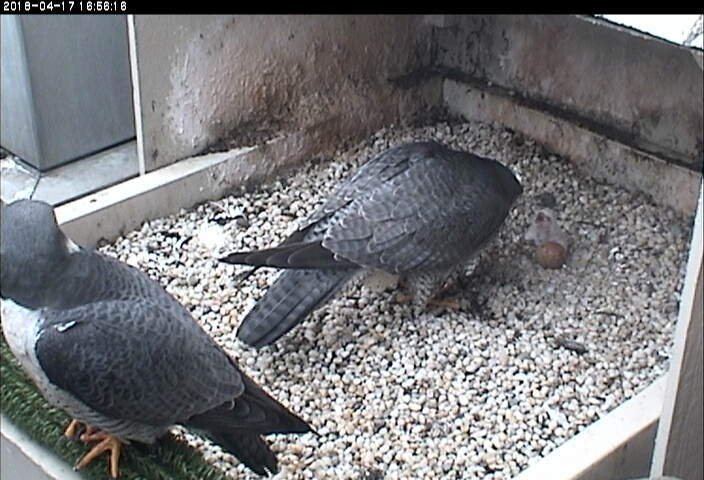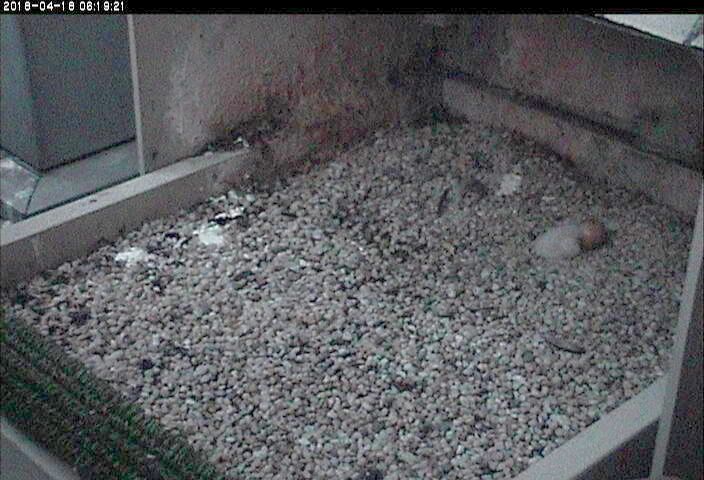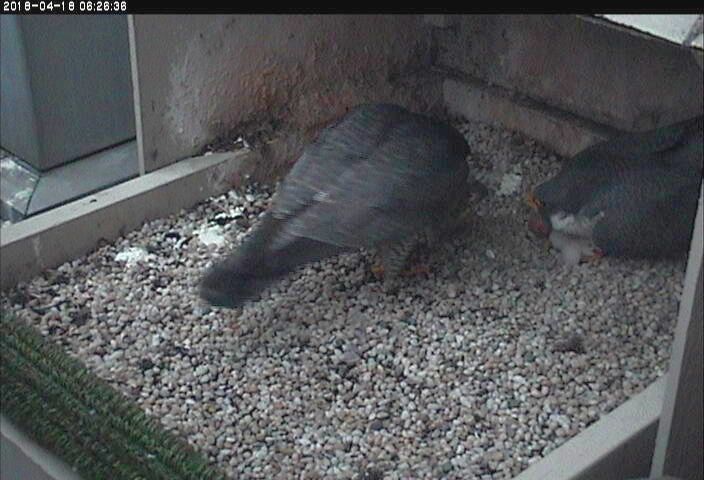
Wednesday April 18, 2018, 7:40am:
Yesterday was hatch day at the Cathedral of Learning nest but it was not a happy day. As the female peregrine Hope has done in the past, she killed and ate some of her young as they hatched. The status right now is:
- April 17, 8:10am: As the first egg began to hatch, Hope picked up the chick, killed and ate it. Her back was to the camera.
- April 17, 9:07am: As the second egg began to hatch, Hope opened the egg, killed and ate the chick in full camera view.
- April 17, 1:35pm: Terzo was on the eggs. Hope arrived and chirped for him to leave. She opened the 3rd egg, picked up the chick and carried it, but did not kill it. Hope eventually brooded the chick and the remaining egg.
- April 17, 4:55pm: Early evening: Terzo brought food. Hope fed the chick.
- April 18, 6:20am: Nest exchange at dawn. Terzo arrives with food. Hope feeds the chick. Then Terzo broods. 1 egg remains.


Why does Hope kill and eat her young?
We don’t know. This is such a rare occurrence that there’s no guidance from similar peregrine nests — they just don’t do this. Meanwhile every idea we come up with is a guess. I prefer not to wade into the guessing.
Unusual behaviors:
Yes, Hope kills and eats her chicks but there are two unusual habits that accompany it:
- Hope opens the egg. The hatching rule for all birds is this: Chicks must open the eggs themselves. At other peregrine falconcams notice that the mother watches but does not touch the shell until the chick has forced open the two halves. Later the mother eats the shell (which is normal). Raptors beaks are sharp and could damage the chick. Normal mother raptors do not use their beaks on the eggs.
- Hope picks up and carries the chick. Normal peregrines don’t pick up their hatchlings. When a chick is outside the scrape (nest bowl) the mother uses the underside of her closed beak to pull the chick back to her. Hope uses her closed beak to arrange the eggs but she breaks that rule when they hatch.
Why doesn’t Terzo stay at the nest and prevent this from happening?
The rule at peregrine nests is that the mother bird is totally in charge. The father bird defers to her.
A corollary is that the mother bird is always present and in charge at hatching time. She calls all the shots, including timing of the first feeding.
The father bird may communicate that he wants something to be different but it’s her decision. When Hope tells Terzo, “It’s my turn to be on the nest!” he has to leave. When he tells her “An egg is hatching” she takes over. This is the way of the peregrine.
What next?
We don’t know what Hope will do with the last egg so these warnings still apply.
A Caution to Viewers:
Don’t watch the eggs hatch at the Cathedral of Learning if it upsets you to see a mother kill her young.
A Caution to Commenters:
If commenters become worked up and demand/request action in emails or phone calls to “those in charge” it will end the show. Literally. It will shut down the camera. That’s what happened when commenters went over the top at the Woods Hole Osprey-cam. So… If you post a comment that could inflame others, I will edit it or delete it.
I’ll let you know when the coast is clear.
Thank you for pointing out the other two unusual behaviors about the hatching! I was wondering about how she opens the eggs and drags the hatchlings around, and if that was normal peregrine falcon behavior. These falcon cams are providing invaluable information.
Aren’t peregrine eggs supposed to hatch at the same time? So is there a good chance the remaining egg won’t hatch?
Robin, last egg is a day+ later. Here’s all the info on it: https://www.birdsoutsidemywindow.org/peregrine-faqs/question-hatching/
Boy it sure would be interesting to see how C1 (or any other of Hope’s female offspring) would behave with their own hatching chicks. Maybe one day one of them will claim a nestcam site of their own.
Interesting question, Lori.
Thank you for calmly talking us through this, Miss Kate.
Thank you for the information, Kate! Also that serves as a warning to me, that there may be an even chance for a repeat of Hope’s first season at Pitt. I do appreciate your advisories. With the increasing number of nest cams out there, perhaps they should institute a rating, like with TV shows? G for happy family nests, and D for drama nests (such as nest takeovers, disturbing or unusual behavior, nest collapses and the like). That way, viewers can be better mentally prepared for what they may witness. Although, I will admit, I am getting somewhat used to Hope’s normal by now …
I’m sorry Hope eats some of her chicks, but if I’m honest, some of that is because I want the fun of seeing them grow up on the nest cam. I feel much worse when a fledged falcon is killed in a window collision or traffic accident. Fingers crossed that chick #3 (and 4 if it hatches) does well!
Hi Kate, Of course we all want to see healthy chicks and see the peregrines contribute to increase the species. But what we also have here is unnatural behavior that has been caught on cam, talked and wrote about. We have it on record now for science, for Ornithology. Even someone like me who just loves birds can see the importance in that. Someday Hope will be gone, but her behavior has been recorded for history. The beautiful COL, and the magnificent Peregrines have never disappointed, Hope and Terzo are continuing that. Thank you and the Aviary and all involved for all you do for these awesome creatures.
Kate shared an article on infanticide in nesting peregrines the first year that Hope selectively reduced her brood, which pinpointed available food sources as being the likely cause. I also found a link on Ospreys that indicates that in areas with abundant prey, it may be more due to the ability of the individual male to collect food. Perhaps Hope’s experiences on the Tarentum bridge made her wary of Terzo’s ability in that area?
https://sora.unm.edu/sites/default/files/journals/auk/v108n02/p0363-p0370.pdf
Also, a study on kookaburras, where the siblings compete, states that early brood reduction creates more robust fledglings than those nests with larger brood size.
https://onlinelibrary.wiley.com/doi/full/10.1034/j.1600-048X.2002.330206.x
I know these aren’t peregrines, but it may give a clue as to why this apparently aberrant and (in peregrines) rare reproductive strategy remains persistent in the breeding population?
Thanks, Robin, … There is plenty of food, an abundance of food. Terzo is a good provider. … It is still a mystery.
When I shared this sad news with my husband, the first thing he said was “maybe there was something wrong with the chick”.. we don’t really know why Hope does this but 3rd chick is looking great so possibly 4th hatch will be uneventful and we can enjoy watching this nest again. Many successful peregrine nests across the country will soon have lots of cute babies to watch. Such an amazing bird to follow.
Thank you Kate for explaining the roles of female and males during hatchings, etc. I know you love these birds and its hard for you to watch what happens also. Thank you so much for the updates, information and all you do. Lets “hope” the last egg will be fine. Have a great day!!
I was thinking that if Terzo was there when the third egg hatched is the reason she did not kill it. It seems she does the unthinkable when he is not at the nest. Hopefully he will be present if and when the fourth hatches. Fingers crossed.
3:30 pm Hope brings food for chick and Terzo leaves. Glad to see this chick is being well taken care of. This is nature and we will not always understand things that happen. In spite of this we still love these creatures!!
Here is an article in Smithsonian Magazine that discusses similar behavior in wild hamsters. Researchers determined that the hamsters have pellagra — which is caused by a vitamin deficiency based on their diet of only corn from the fields they live in. Given vitamin B3, their behavior becomes normal again.
https://www.smithsonianmag.com/science-nature/why-hamsters-cannabalizing-their-young-180968071/